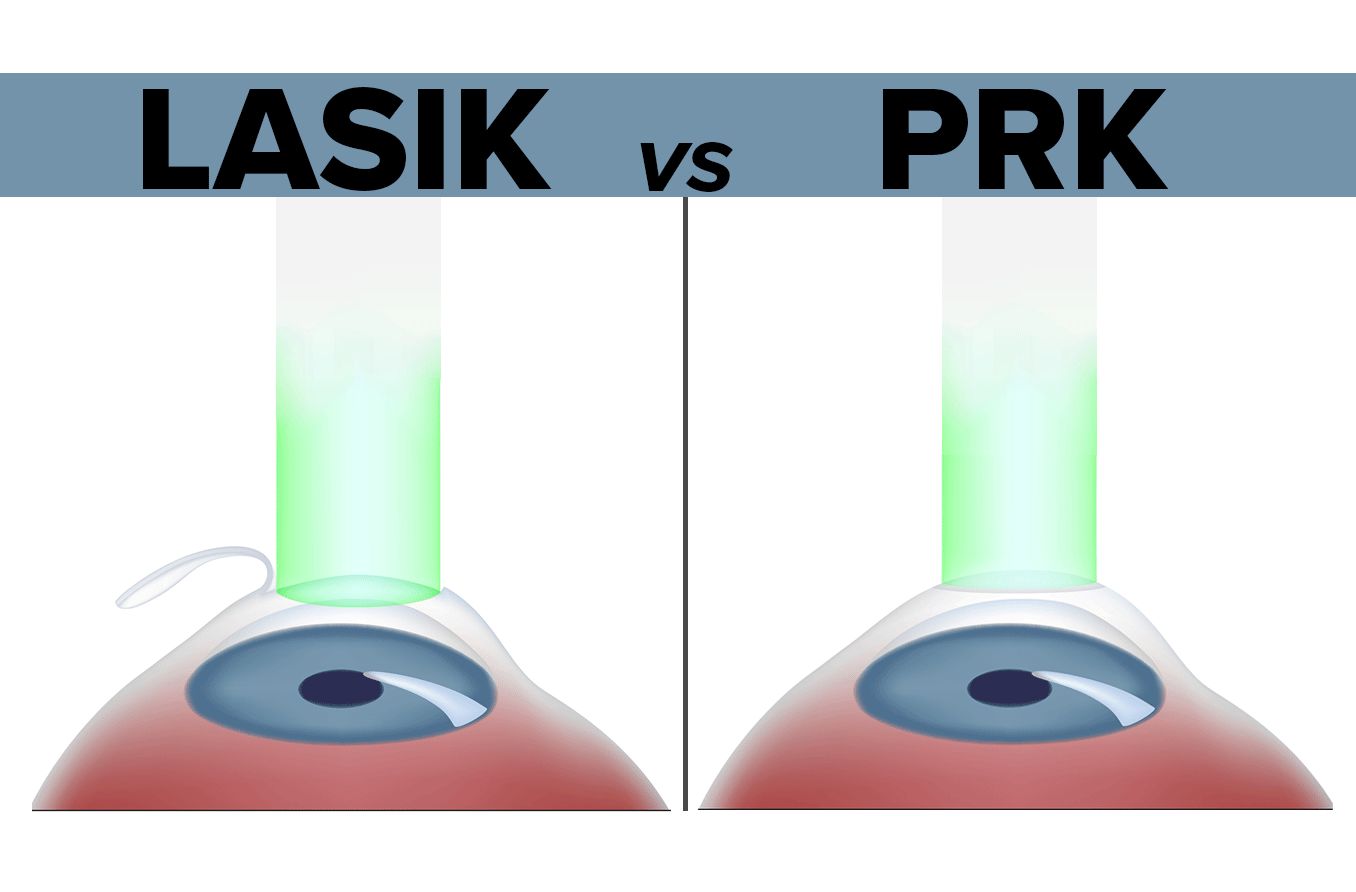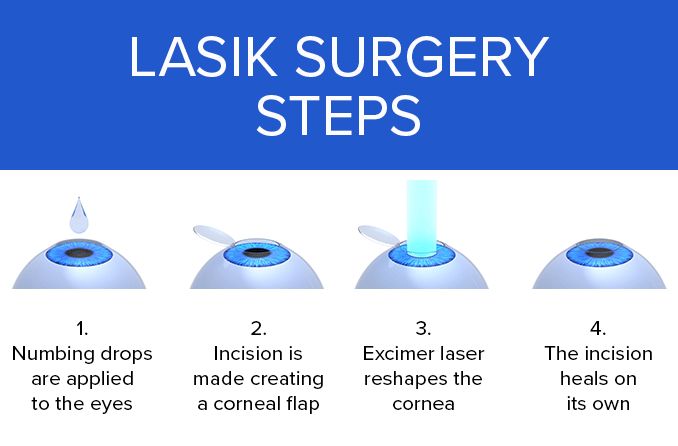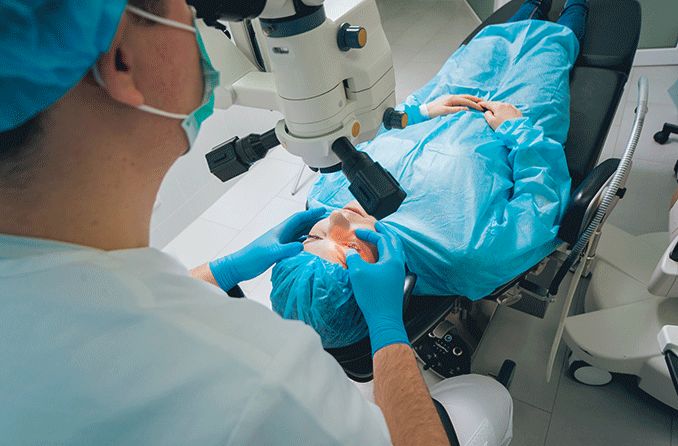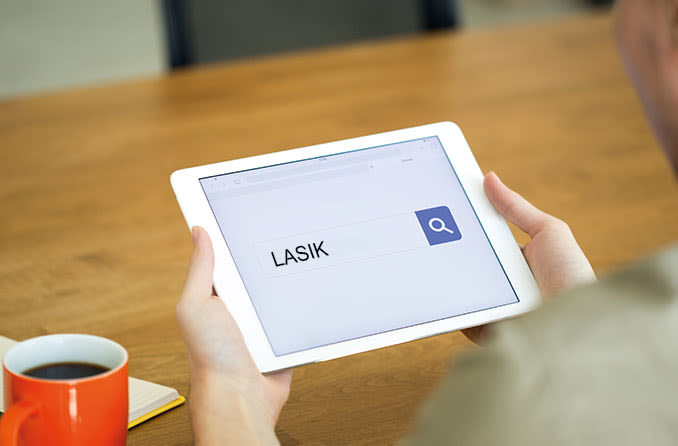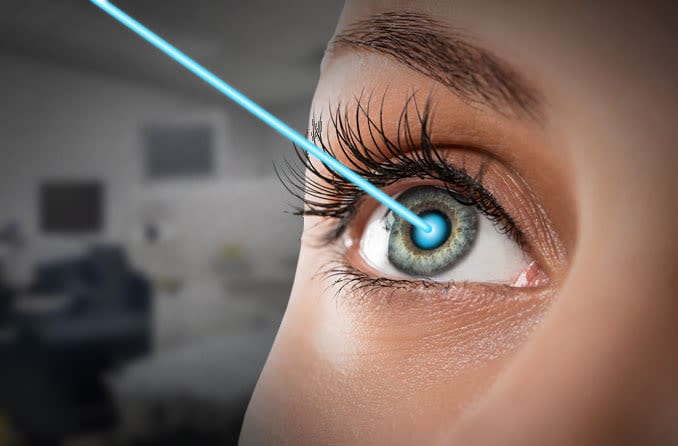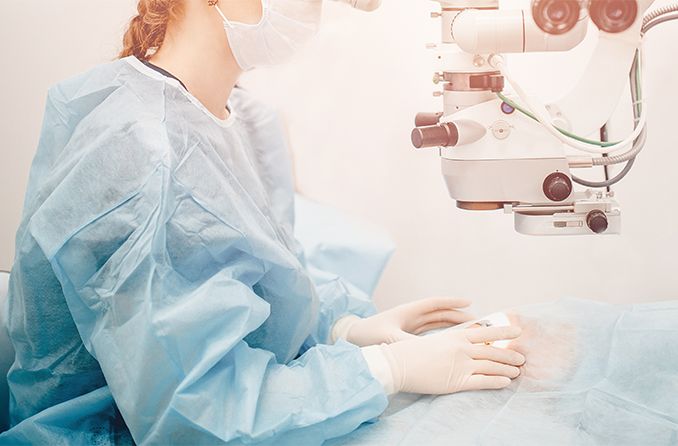What is PRK surgery?
Photorefractive keratectomy (PRK) is a type of laser eye surgery that corrects certain vision conditions called refractive errors. It works by reshaping the cornea, the clear front surface of the eye. This helps the cornea refract (bend) light onto the retina correctly, allowing for clearer vision.
PRK is an effective way to treat refractive errors, such as myopia (nearsightedness), hyperopia (farsightedness) and astigmatism. It can reduce, and sometimes even eliminate, the need to wear prescription glasses or contact lenses.
How does PRK compare to LASIK?
Laser-assisted in situ keratomileusis (LASIK) is another type of vision correction procedure. Both PRK and LASIK reshape the cornea to correct refractive errors, but they differ in a few key ways:
Surgical procedure
During PRK, the outer layer of the cornea, called the epithelium, is removed. (This usually grows back within three to five days after treatment.) The exposed layer of the cornea, known as the stroma, is then reshaped.
With LASIK, a thin flap is created in the corneal epithelium and folded back. The stroma is then reshaped, and the flap is put back into place.
Recovery time
The recovery period for PRK lasts several weeks. Post-treatment discomfort is typically managed with over-the-counter (OTC) pain relievers and bandage contact lenses.
The recovery period following LASIK typically only lasts a few days, and discomfort is usually minimal.
Candidate eligibility
PRK may be suitable for some people, whereas LASIK is better for others. For instance, PRK may be preferred for those who:
- Have dry eyes.
- Have unusually shaped corneas.
- Have thin corneas.
- Are highly active or play contact sports.
If you’re considering corrective eye surgery, your eye doctor can help determine if PRK, LASIK or another option is right for you.
READ MORE: PRK vs. LASIK: Cost, differences, pros and cons
Who is a good candidate for PRK?
To be considered a good candidate for PRK surgery, you’ll need to meet the following basic criteria:
- Be at least 18 years old (preferably 21 or over, when vision tends to be more stable)
- Have a stable vision prescription (with no change over +/-0.5 diopters in the past year)
- Have good eye health (especially a healthy cornea)
You should also have one of the common refractive errors that PRK is used to treat, which includes:
- Myopia (nearsightedness) – Near vision is clear, but distance vision is blurry.
- Hyperopia (farsightedness) – Distance vision is clear, but near vision is blurry.
- Astigmatism – Vision is blurry at all distances.
Presbyopia is a refractive error that develops with age (usually around 40). It makes it difficult to see clearly close up at a reading distance. While PRK cannot correct presbyopia, it may be used for monovision, where one eye is corrected for near vision and the other for distance vision.
When PRK might not be right for you
PRK may not be an ideal vision correction option if you have or have had certain eye conditions, such as:
- Cataracts
- Glaucoma
- Corneal abnormalities (such as keratoconus)
- Blepharitis
- Dry eye syndrome
- Eye allergies
Certain systemic factors can also affect PRK candidacy, including:
- Connective tissue diseases (such as rheumatoid arthritis and lupus)
- Diabetes
- Pregnancy
- Lactation
- Medications that cause eye side effects
What happens during the PRK procedure?
Here’s what you can expect throughout the entire PRK process, from the initial consultation to the procedure itself:
Preparing for your surgery
Before scheduling your PRK procedure, you’ll have a consultation with your eye surgeon. They’ll review your medical history along with any medications and supplements you take. Your surgeon will also perform a comprehensive eye exam and specific eye measurements, including corneal mapping (topography) and a corneal thickness measurement (pachymetry), to assess your eye health.
During this visit, your eye surgeon will explain what to expect throughout the process, answer any questions you have and set realistic expectations for your vision outcome. They’ll also outline any steps you need to take in preparation for your procedure. This may include:
- To avoid certain medications or supplements (do not stop taking your medications unless instructed by your doctor)
- When to stop eating or drinking in the hours leading up to your procedure
- To avoid using lotions, perfumes and similar products on your face
- Not wearing any jewelry to your appointment, including piercings
- Not wearing your contacts (if you normally use them)
PRK surgery is performed on an outpatient basis, meaning you aren’t admitted to a hospital and don’t have to stay overnight. You’ll need to arrange to have someone drive you home following your surgery.
The day of your surgery
You’ll remain awake for your procedure, but your eye doctor will place numbing drops in your eyes to help keep you comfortable. Additional drops may be used to control inflammation and reduce the risk of infection.
PRK surgery typically takes anywhere from five to 30 minutes to complete, and one eye is treated at a time. The procedure involves the following steps:
- A device is used to hold your upper and lower eyelids open.
- The outside layer of the cornea is gently removed. It’s normal to feel minor pressure on your eye during this step.
- You’ll be instructed to focus on a specific target (usually a light) on the laser device.
- An excimer laser is then used to reshape the exposed layer of your cornea and improve the refractive error. It’s normal to hear a clicking sound coming from the laser.
- Drops are placed into your eyes, and a bandage contact lens is applied to protect the cornea as it heals.
- The device holding your eyelids open is removed, and post-treatment instructions are provided.
What is the recovery like after PRK?
A common concern about PRK surgery is what to expect in the recovery phase. Recovery typically occurs in the following stages:
The first few days: Healing and discomfort
It’s normal to experience some eye discomfort in the first few days after PRK surgery. However, this can usually be managed with OTC pain relievers.
While you may briefly notice sharper vision immediately following the procedure, your vision will probably be blurry for the first three to five days. You may also notice symptoms, such as:
- A stinging sensation
- A gritty feeling (like sand is in your eyes)
- Eye redness
- Eye irritation
- Eye dryness
- Photophobia (light sensitivity)
- Watery eyes
- Glare, starbursts or halos around lights
- Difficulty seeing in dim lighting
You’ll need to visit your eye surgeon within three to five days following your surgery to have the bandage contact lenses removed. This is typically the time it takes for the corneal surface to regenerate.
Following post-treatment recommendations
It’s important to follow all of your eye doctor's recommendations as you heal and recover from PRK. These may include:
- Using medicated eye drops exactly as prescribed.
- Avoiding swimming and hot tub use for one to two weeks.
- Avoiding makeup and skin care products until your doctor says it’s safe to use them.
- Avoiding exercise or strenuous physical activity until approved by your eye doctor.
- Wearing sunglasses with 100% ultraviolet (UV) protection when outdoors.
- Waiting to return to work or school until your doctor says it’s safe to do so.
- Waiting to drive until your vision is no longer blurry (usually within a week).
The first few months: Vision improvement
Visual improvement following PRK is usually gradual. It can take three to four weeks for your vision to stabilize and up to three months for your eyes to completely heal.
Around 90% of people who have PRK surgery achieve visual acuity of 20/40 or better, while 70% achieve 20/20 vision without the use of glasses or contacts.
It’s important to know that PRK does not prevent the development of presbyopia. You may still need to wear reading glasses to see clearly up close starting around age 40.
What are the risks of PRK?
As with any eye procedure, PRK surgery carries certain risks, including:
- Corneal haze (clouding of the cornea)
- Corneal scarring
- Corneal infection
- Seeing glare or halos around lights (especially at night)
- Overcorrected or undercorrected vision
In very rare cases, a person’s vision may be worse than it was before having PRK surgery, despite the use of corrective lenses. This is referred to as the loss of best-corrected vision.
Your eye doctor can help you understand these risks and how they could potentially affect your eyesight.
Frequently asked questions about PRK surgery
People considering PRK for vision correction often have specific questions about the procedure. Below are some of the more common questions and answers:
Does PRK surgery hurt?
You may experience mild discomfort and pressure during the procedure. However, your eyes will be numbed with special drops to increase your comfort.
It’s common to experience some eye discomfort for two to three days following PRK. This is usually managed with OTC pain relievers and the use of soft contact lenses. However, stronger pain medications may be prescribed if needed.
How long do the results of PRK last?
PRK surgery results typically last a long time unless you experience changes in your vision. One such change is presbyopia, which develops with age and can affect your ability to see clearly at a reading distance. With presbyopia, you may need reading glasses to see clearly up close.
How much does PRK cost?
The estimated cost of PRK surgery in 2025 is around $2,250 to $2,500 per eye, which is $4,500 to $5,000 for both eyes. Check with your eye surgery provider beforehand to understand the cost of your specific procedure.
PRK is not usually covered by insurance since it’s considered an elective procedure. However, it may be a qualifying expense under flexible spending accounts (FSA) and health savings accounts (HSA). Some providers may also offer financing options.



